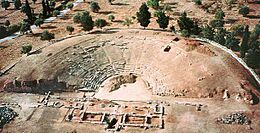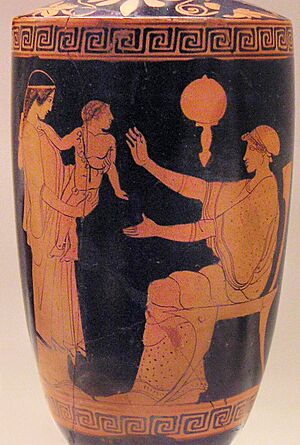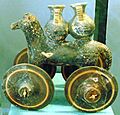Archaeological Museum of Eretria facts for kids

Ancient theatre in Eretria
|
|
| Established | 1960 |
|---|---|
| Location | |
| Type | Archaeological museum |
The Archaeological Museum of Eretria is a cool place in Eretria, a town in Greece. It's located in the Euboea region of Central Greece. This museum is special because it shows off amazing ancient objects found nearby.
The museum first opened its doors in 1960. It was made bigger in 1961 and 1962 to hold more treasures. Later, between 1987 and 1991, it got another big update. This was done by the Greek Archaeological Service working with the Swiss School of Archaeology in Greece.
Contents
What You Can See at the Museum
The museum is right next to an ancient site in Eretria. It holds many artifacts, which are old objects, found in places like Xeropolis, Skoumbri, Palaia Perivolia, and Toumba in Lefkandi. You can also see items from Paliochora and Geraki hill in Amarynthos, and from Magoula. However, some important finds from Eretria are shown in other famous museums. These include the National Archaeological Museum in Athens and the Louvre in Paris.
Amazing Finds from Ancient Times

One of the most famous items is a clay centaur from Lefkandi. A centaur is a mythical creature that is half-human and half-horse. This figurine is very old, from the 10th century BC. What's really interesting is that it was found broken into two pieces. Each piece was placed in a different grave!
Another cool find from Lefkandi is a Mycenaean alabastron. This is a small, straight-sided jar with three handles, from the 12th century BC. It has a dark surface with white designs. You can see pictures of a griffin, a roe deer, and a regular deer on it.
Pottery and Vases
The museum has a special type of pottery called a black-figure epinetron from Amarynthos. It's from the late 6th century BC. There's also a large burial jar, called a funerary amphora, from the 8th century BC. This jar has cool geometric patterns and birds. It even held the bones of a child!
You'll find many more amphoras and vases. One funerary amphora from Eretria, from 560 BC, shows a battle between the hero Herakles and Centaurs. On the back, it shows Potnia Theron, which means "Mistress of the Animals." There's also a Panathenaic amphora from around 363-362 BC. These vases were prizes in the Panathenaic Games, a big sports event. This one shows the goddess Athena on the front and a scene from the contest on the back. Don't miss the clay gorgoneion from the 4th century BC. This was a scary face decoration from a house in Eretria.
Ancient Sculptures
Excavations in Eretria have uncovered some amazing sculptures. Many are now in the museum. These include pieces from the ancient temple of Apollo Daphnephoros. They show an Amazonomachy, which is a battle between Greeks and Amazons, who were mythical female warriors. A very special sculpture shows Theseus and Antiope. People believe it was made by a famous artist named Antenor in the 6th century BC.
Other Unique Items
The museum also displays pieces of ancient storage jars, called pithos fragments. These are from the 7th century BC and show birds eating bodies. You can also see a necklace made of faience beads. These beads show the Egyptian gods Isis and Horos. This necklace might have come from Cyprus and dates back to the 11th-10th centuries BC.
Gallery
-
Theseus and Antiope, around 510 BCE.






